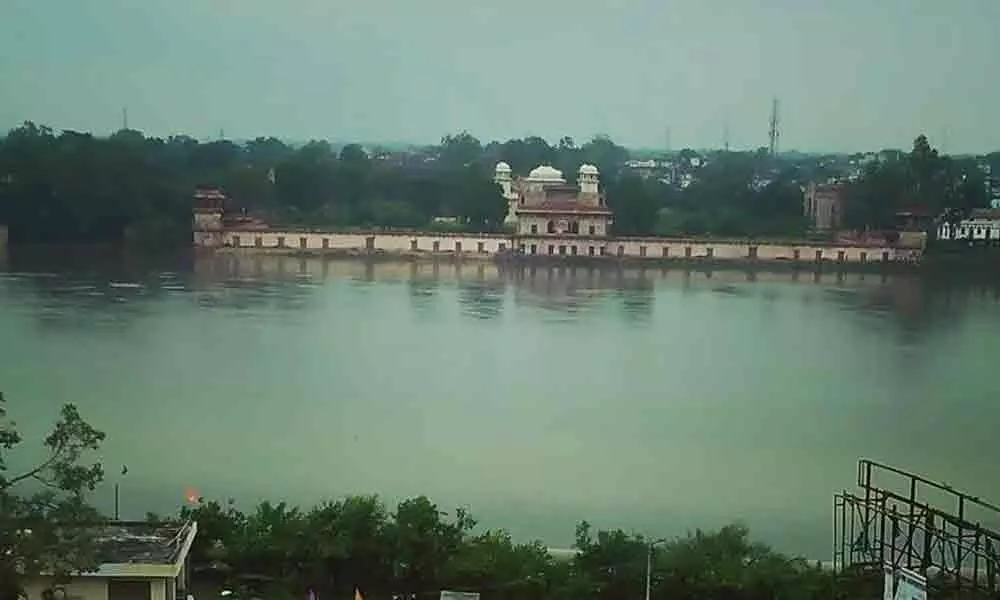Taj Mahal dazzles as river Yamuna in spate

Taj Mahal dazzles as river Yamuna in spate (Photo/IANS)
With the Yamuna still continuing to remain in spate in Agra, the rear view of the Taj Mahal stands transformed as the river is full of life-sustaining water, following incessant rains, providing a magnificent view from the Mehtab Bagh.
Agra: With the Yamuna still continuing to remain in spate in Agra, the rear view of the Taj Mahal stands transformed as the river is full of life-sustaining water, following incessant rains, providing a magnificent view from the Mehtab Bagh.
From a "sickly sewage canal," the Yamuna river stands as a vibrant and attractive water body which is said to be the lifeline of the city.
Heaps of garbage that had accumulated along the banks have now been swept away.
"The banks are now cleaner and greener thanks to the monsoon rains. The chirping birds are back and people stop by for a while to enjoy the spectacle of the Yamuna in its pristine glory," said Nandan Shrotriya, a temple priest of the Yamuna Kinara road.
Though the Taj Mahal remains closed for visitors due to the Covid-19 pandemic, the ambience of the area stands transformed as the Yamuna at the rear of the monument provides a magnificent view from the Mehtab Bagh. Emperor Shah Jahan built the Taj Mahal because of the Yamuna river, but in the past few decades, the river has become a dying lifeline. For most part of the year "it remains a sickly drain," said a river activist Shravan Kumar Singh.
Right now the river is full of water, but for how long?
"For almost eight months in a year, the Yamuna remains dry and polluted as upstream barrages from Hathini Kund to Wazirabad, Okhla and Gokul hold back all the water. The downstream cities suffer as a result. The need is to ensure a minimum flow of water round the year so that the river remains alive and the aqua-life is not disturbed," says environmentalist Devashish Bhattacharya.
Over 500 years ago, it was the grandeur of the Yamuna that had attracted the founder of the Mughal dynasty to open shops in Agra. In later years, his descendents chose to build some of the finest monuments like the Taj Mahal and the Etmaduddaula along its banks.
While the younger folk have generally stayed away from the stinking river which holds no charm for them, people of the older generations do occasionally venture out to conduct ritualistic pujas and baths.
The dozen-odd ghats along the riverfront, which once was the centre of a thriving commercial activity and river culture, have disappeared without a trace, reducing the 20 km-long riverfront to a vast wasteland.
From the Kailash temple to the Dussehra Ghat adjacent to the Taj, there were more than a score of permanent ghats, some of red sandstone and others of marble. Behind the Red Fort there were permanent ghats with highly decorative canopies for the royal females of the Mughals.
Some ghats fell prey to man's indifference, others were razed to the ground by zealous bureaucrats on the late Sanjay Gandhi's orders during the Emergency (1975-77) to make way for a "picturesque" river front like Mumbai's Chowpati. But before that dream could materialise, politics took a U-turn and Indira Gandhi was swept out of power in the 1977 General Elections after the emergency was lifted, recalled river activist Padmini Iyer.
Today, the river of decadence is an eyesore. Those who take the Yamuna Kinara road are often seen covering their noses to keep away the foul odour of the stinking mess. "Modi's minister Nitin Gadkiri had promised steamers in Yamuna will bring tourists from Delhi to Agra. Now he seems to have forgotten or has given up the project," commented Wake Up Agra president Shishir Bhagat.
River Connect campaigner Pandit Jugal Kishor lamented: "Those were the days when the citizens of Agra used to spend leisurely summer evenings on the river bank, which had a long row of temples. Children used to feed the tortoises and a whole lot of cultural and religious activities used to be held here. But now the people have turned away and have even forgotten there's a river in the city."
Hathi Ghat near the fort still survives but the entire area has been rampaged by transport companies, whose vehicles are parked there. Nathi Lal of Katcheri Ghat warned: "If the ghats disappear, the river culture, the annual melas and 'tamashas', the 'tairaki' (swimming contests), 'patangbazi' and the mass bathing programmes on festivals would vanish too."
Citizens groups like the River Connect Campaign have been exerting pressure on the government agencies to take up cleanliness drives, build permanent ghats and dredge out silt from the riverbed to hold back the monsoon overflow, but so far there has been no positive response, commented K. C.Jain, secretary Agra Development Foundation.
The Braj Mandal Heritage Conservation Society has urged the Yogi and Modi governments to replicate the Sabarmati model in Agra and Mathura. "The Sabarmati river in Ahmedabad was reduced to a dirty drain, but the then state government headed by Narendra Modi carried out structural changes and the success is there for all to see," society president Surendra Sharma said. Work on the Yamuna barrage downstream of the Taj Mahal should begin urgently, he added.

















